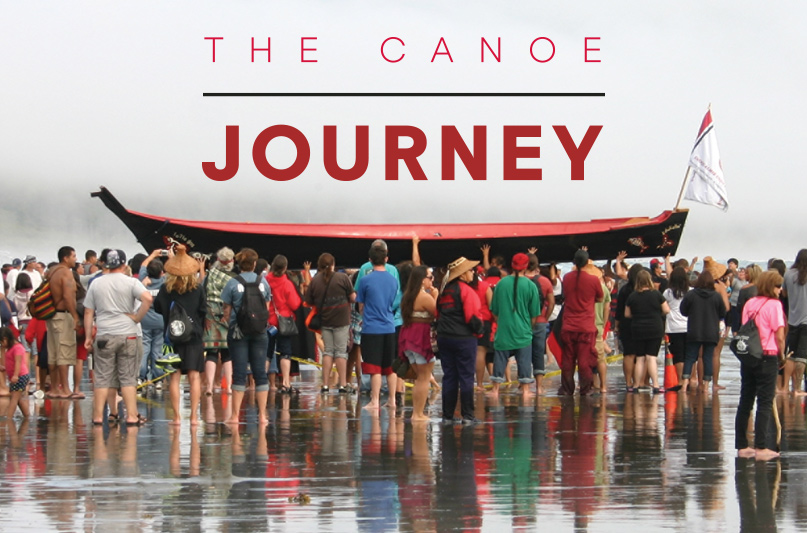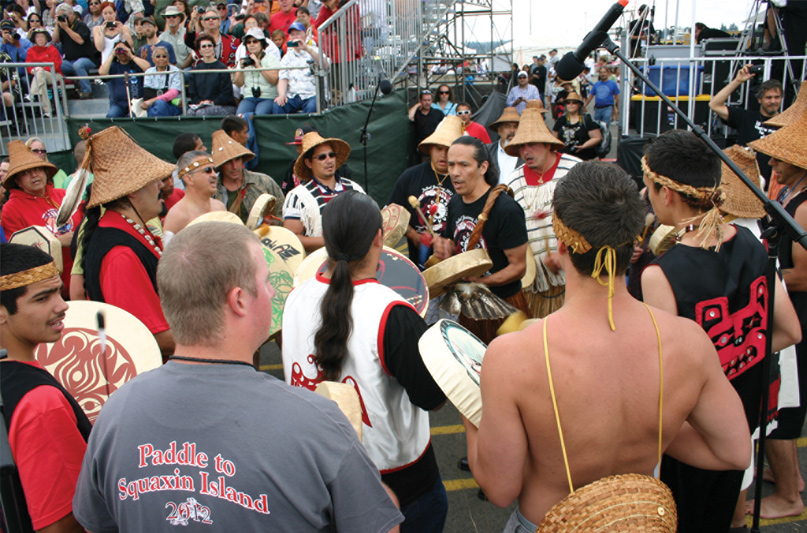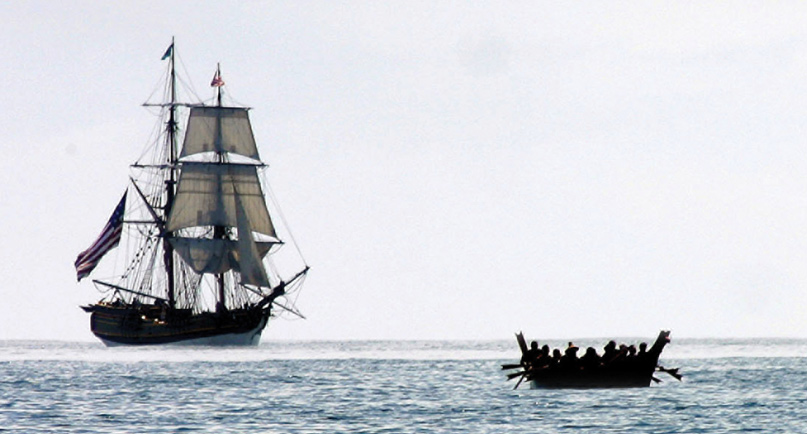
 ou hear the songs coming across the water before the prows of 11- and 13-person Northwest indigenous canoes come into view. One by one, the canoes draw close to shore. Each skipper stands to ask in his or her language for permission to land. Then, there is welcome and celebration.
ou hear the songs coming across the water before the prows of 11- and 13-person Northwest indigenous canoes come into view. One by one, the canoes draw close to shore. Each skipper stands to ask in his or her language for permission to land. Then, there is welcome and celebration.
This scene is repeated at each stop along the route of the Intertribal Canoe Journey, the annual late summer gathering of Northwest Native peoples, as canoe pullers travel from their home territories to that year’s host destination.
This year, an estimated 100 canoes will travel from indigenous nations in Washington, British Columbia, and elsewhere to the Lummi Nation near Bellingham.
The Canoe Journey is a maritime event like no other. It’s an athletic feat requiring human-powered travel over hundreds of nautical miles. It’s a logistical feat; the Lummi Nation expects to host 10,000 people July 24 to 28 for traditional meals, gifting, and round-the-clock sharing of songs and dances by visiting indigenous nations.
To top it all off, the Canoe Journey is open to the public as an introduction to a Northwest Native cultural renaissance.
The first Canoe Journey sparked an awakening in 1989, the year Northwest Native canoes returned to Puget Sound for the Paddle to Seattle as part of Washington’s centennial celebration.
Keep in mind the time: Congress had passed a law only 11 years earlier protecting the religious freedoms of Native Americans; the federal government formally abandoned in 1988 efforts to terminate relationships with the indigenous nations with whom it had signed treaties; and boarding schools, where the grandparents and great-grandparents had been sent involuntarily, were only now closing.
The ink was still drying on the law legalizing Indian gaming, which would generate the seed money to fuel a new era of economic development in Indian Country.
Indigenous peoples in Northwest U.S. and Canada had endured more than a century of cultural suppression, and the return to the traditional way of traveling upon the ancestral waters was bringing the culture back: the art of canoe carving, the hosting of potlatches, the teaching of languages, dances and songs. It bolstered a new generation’s sense of identity.

“Since Uncle Smitty (Hillaire) came to Lummi’s leadership and asked for permission to host (the 2007 Canoe Journey), it’s brought back a lot of those teachings,” said Candice Lane Wilson, executive director of the Lhaq’temish Foundation.
Lhaq’temish is the Lummi people’s historical name. “It’s about our culture and the teachings—the language, the songs, the regalia. To see our children carrying on these teachings is phenomenal.”
Sam Barr is a citizen of the Samish Nation and deputy historic preservation officer for the Stillaguamish Tribe.
“The Canoe Journey has been a way for youth to get involved in the culture in a really healthy way,” he said. “It’s alcohol-, drug-, and tobacco-free. You’ve got all the training and practices, you’ve got the healthy lifestyle.
You’ve got to learn how to work together, how to paddle together. You’ve got the protocols and the songs and the dances. For youth who are looking to strengthen their identity, trying to learn more about their family history, and trying to connect to that feeling inside them, the Canoe Journey is an awakening for that.”
The cultural revival sparked by the Canoe Journey has attracted the interest and participation of other Pacific Rim canoe cultures. Participants in this year’s Journey will include Alaska Natives from Juneau; Maori from New Zealand; Papuan from New Guinea; Nuxalk from Bella Coola, British Columbia; and descendants of Kamehameha, the 18th and 19th century kings of Hawai’i.
The Canoe Journey also reinstates the indigenous presence on the Salish Sea – as well as the canoe prowess of the First Peoples. Long before Captain George Vancouver’s ships explored these waters and the local seascape was dotted with commercial ships and recreational boats, the Salish Sea was trafficked by large, hand-carved canoes traveling to resource harvesting sites, to places of commerce and trade, and to gatherings and celebrations.
“The first Europeans into this area were amazed at the carrying capacity and beautiful construction of the Northwest Coast canoes,” a writer for the online forum Native American Netroots reported, citing written observations from that time. “In a moderately sized canoe, two paddlers were able to make about 40 miles in a day.”
Freddie Lane, a Lummi Nation councilman, noted that the Coast Salish people were the first professional marine pilots of these waters, escorting Vancouver’s ships to safe anchorages, and later transporting settlers to places of trade. Had the people not reclaimed the right through the Canoe Journey, Lane said, traveling the way of their forebears on the ancestral marine highways would have been lost.
“From what I remember, in 1989, when our elders talked about traveling on the Salish Sea, we were being challenged—that by not traveling our ancestral highways we would lose them,” Lane said. “The Canoe Journey is bringing it all back—the unity, the potlatches. After the diseases and the boarding schools, we’re still here.”
For the non-Native guest, the protocol and potlatch that takes place during the Canoe Journey is a cram course in Native culture. It’s also a privilege to attend.
Protocol is important part of the event in which representatives of each visiting Native Nation shares its culture with dances, songs, gifts. Presenters will often wear traditional clothing, called regalia. Some clothing a guest might see: capes, skirts, and vests woven of cedar and perhaps mountain goat wool; elaborately embroidered and beaded shawls; and woven cedar hats and headdresses. Speakers will speak first in their native language.
Dances and songs will be shared and usually the men will drum and the women will use intricately carved rattles made of cedar or alder. Many dances and songs are quite old and are inherited or gifted. The representatives will honor and present gifts to the hosts, and gifts may be presented to guests as well.

The host nation, this year the Lummi Nation, will conclude the Journey with a potlatch, in which it shares its own culture, honors the next year’s host, and distributes gifts to all guests. In today’s world, wealth is often measured by how much one accumulates.
In Northwest Native America, wealth is measured by one’s generosity. Hence the potlatch, a historical system of wealth redistribution that the governments of the United States and Canada long tried to suppress.
Being a potlatch guest came with some responsibility.
Historically, a potlatch guest would receive gifts but would also be on-hand to witness a marriage, the passing on of a name, or the inheritance of intellectual property. The guest would be a carrier of the history of that event, able to recount it for posterity. So, it is with the 2019 Canoe Journey. Lummi’s potlatch guests will go forth, able to recount Lummi’s generosity for posterity.

“The Canoe Journey is a way for us to show who we are as Lhaq’temish people,” Wilson said. As of June 15, the Lummi Nation had invested $600,000 in hosting, and the Lhaq’temish Foundation had raised another $150,000.
The Canoe Journey has also given First Nations and Tribes a forum to call attention to issues and to propose solutions.
The Canoe Journey led to the development of “The Healing of the Canoe” Culturally Grounded Life Skills for Youth curriculum. This is an evidence-based, strength-based life skills curriculum for youth that uses community-based and culturally grounded strengths and resources to promote well-being and prevent substance abuse.
For several years beginning in 2008 in partnership with the U.S. Geological Survey, several canoes carried devices that recorded water temperature, salinity, turbidity, dissolved oxygen, and pH levels to help the USGS map areas of water quality concern in the Salish Sea.
In the 2011 Canoe Journey, Ta’Kaiya Blaney, the young singer, actress, and environmental activist from the TlaA’min First Nation, wowed the crowd on the protocol floor with her song, Shallow Waters. The song tells of the dangers of being silent to environmental risks: “The lifeless ocean, black not blue / I didn’t help but deep down I knew …”

And leading up to the 2019 Journey, representatives of the Lummi Nation toured several states with a totem pole honoring the killer whale (“qwe ‘lhol mechen” in the Lummi language) as a call to action “rather than endless deliberation” to protect endangered Southern Resident orcas and salmon from pollution and other stressors on Salish Sea ecosystems.
The population of Chinook salmon, on which Southern Resident orcas feed, is down 60 percent since the Pacific Salmon Commission began tracking salmon data in 1984, according to the U.S. Environmental Protection Agency. Two big factors, according to EPA, are habitat degradation and warmer water temperatures.
The health of the salmon tells a lot about the health of the environment. And those are not just Native American issues, but issues affecting everyone, Wilson said. “We need to call attention to our public health, our environment, our salmon, and our orcas.”
Just as the Canoe Journey has helped bolster a new generation’s sense of identity, it has also helped bolster the political standing of Native Nations. Events like the Canoe Journey “give validity to our political entity,” Samish historian Barr said. “When it comes to treaty rights, it’s definitely a big thing.”
The Bureau of Indian Affairs (BIA) recently ruled that the Samish Nation—which was dropped from a list of federally recognized tribes in the 1960s and fought for re-recognition for nearly 30 years—had a relationship with the United States prior to 1934, qualifying it to have land placed into trust. Tribal governments have jurisdiction and authority over their trust land.
That BIA decision happened “because our tribal members, our predecessors, including my great-grandmother, all kept that culture alive,” Barr said.
“They kept the culture and politics alive in perpetuity since the treaty, and the federal government was forced to recognize ‘You were doing this before, you’ve been doing it this whole time, and you’re still doing it; and so we’re going to give you full-on recognition.’”
He added, “The Canoe Journey has done a lot in the Pacific Northwest to raise awareness of the history” of the First Peoples of the Salish Sea.